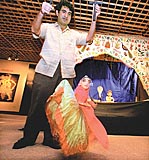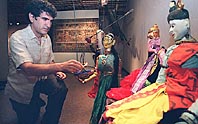 Traditions pull the strings Traditions pull the strings
By Mike Leidemann
Advertiser Staff Writer
Some of the world’s greatest stories are best told in miniature.
 |
| Mike Schuster handles a puppet from northern India.
Deborah Booker • The Honolulu Advertiser |
That’s one idea behind a new exhibit of carved wooden puppets from Asia on display at the East-West Center.
"Puppets allow the whole cosmos to be shrunk into a miniature world and presented in one space," said Michael Schuster, folk arts coordinator for the State Foundation on Culture and the Arts. "They help make epic stories understandable."
The art of puppetry in South Asia and Southeast Asia dates back thousands of years and cuts across many cultures. The earliest puppets were found nearly 2,000 years ago in India, and the tradition thrives today in Indonesia, Thailand, Myanmar, Vietnam and elsewhere.
Seeing the intricately carved and elaborately costumed puppets together in the East-West Center gallery at Burns Halls makes the cultural connections obvious. Similar characters — princes, clowns, demons — appear in all the traditions. Stories, staging, even puppeting techniques have clearly moved back and forth across centuries and thousands of miles.
The puppets are dazzling.
"They are supposed to be," Schuster said. "The puppets bring the spirit of the heavens and the gods to earth, and through them the spirits can enter into us, the audience."
| 'Carved Puppets of Asia'
 East-West Center Gallery, 1601 East-West Road East-West Center Gallery, 1601 East-West Road
 8 a.m.-5 p.m. weekdays; noon-5 p.m. Sundays; closed Saturdays 8 a.m.-5 p.m. weekdays; noon-5 p.m. Sundays; closed Saturdays
 Indian puppet demonstration: 10 a.m. Feb 12 and Feb. 15 Indian puppet demonstration: 10 a.m. Feb 12 and Feb. 15
 Indonesian puppet demonstrations: 10 a.m. March 16 and March 19. Indonesian puppet demonstrations: 10 a.m. March 16 and March 19.
 Information and to schedule group tours: 944-7584. Information and to schedule group tours: 944-7584.
|
Schuster and Kathy Foley, provost at Porter College in California, have spent years researching the Asian puppetry tradition and collecting the puppets that make up the display. Both also are accomplished puppeteers. Schuster once traveled on foot across Israel with a donkey, stopping along the way to produce shows of Rajastani puppets that have the ability to delight kids of all ages and languages.
"While the puppetry tradition is very much alive in Asia, it’s unusual to see these many cultures represented together," said Benji Bennington, curator of the East-West Center gallery. "This allows you to see the relationship from one culture to the next."
Almost all the puppets in the show are colorfully decorated, highly stylized and filled with a definite spiritual quality.
"There’s no great division between the spiritual and the mundane in Asia," Schuster said. "Clowns can be powerful gods; the royal court and the village each play important parts in the puppet world."
Traditionally, puppets have been used to entertain and educate around the world. In Southeast Asia, puppetry continues to be one of the central facets of maintaining cultural life.
"In some places like Indonesia, the puppets remain very much a part of the daily life. Performances are held for births, weddings, and other important occasions," Benjamin said.
 |
| These Thai puppets are part of the East-West Center display.
Deborah Booker •The Honolulu Advertiser |
In other places, particularly where political powers tended to tightly control local culture, puppetry teetered on the brink of extinction just a decade ago, Schuster said. In Myanmar and elsewhere, though, there’s been a revival in recent years, helping to keep the art alive.
The puppeteers, either individuals or small troupes, keep the art alive by constantly updating and changing their stories.
In Indonesia, the puppetmaster, known as a dalang, creates a different story with each performance, drawing on familiar characters to have new interaction every night.
Everywhere, the puppeteers can take a centuries-old story and mix in modern politics or current events. Almost always, the shows are accompanied by live music and live narration, he said.
"Everything can be included in the show," Schuster said.
"In the West, the theatrical experience usually has to be one thing or the other, either ‘Hamlet’ or ‘Midsummer’s Night’s Dream,’ " he said. "In Asia, it could be both of those, plus ‘The Lion King,; the Bible, the Bhagavad Gita, and Woody Allen, too. The puppets show everything in the cosmos. It’s a total experience."
Schuster said there’s a little-known tradition of puppetry, called hula ki‘i, in Hawai‘i.
"It’s so tough to keep these things alive," he said. "We really need to understand and appreciate the rich traditions we have all around us."
[back to top] |

 The Great Index to Fun
The Great Index to Fun
